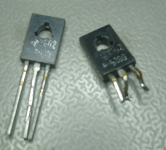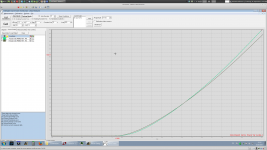In despite the fact you have build on this topology yourself, with 16 JFETs in parallel and yes, including the inductive gate stoppers, obvious in the photo of the board.
Yes, because an array of 16 CPH3910 can oscillate happily at 600 MHz;
the not so concentrated wiring around the transistors can make
a distributed resonator if not damped. Every transistor with a different amplitude
depending on the location in the matrix. Best seen with a really fast scope and
a 0.6 pF active probe. Easily solved with beads for this frequency range.
That has nothing to do with your unsolved 800 KHz problem.
I have no idea what dragon you are trying to slay, but I do know I am over and out.
Promised?
The new BUF802 is a high speed buffer with a JFET input: BUF802 data sheet, product information and support | TI.com
What voltage rating (VCE) did you have in mind for that SiGe PNP?
We live now in a 5V world or even less, so it should survive that, with some reserve
for a tank circuit effect.
Vceo is not important, nobody is forced to leave the base open.
That makes for much nicer numbers.
I have not yet digested the BUF802 ds, Mouser and DK have no stock but Mouser
knows at least the eval board.
Gerhard
(just playing with a LMX2594 EVM)
Last edited:
A big thank-you to the T.I. folks who found my order-gone-wrong and got it fixed. I've now bought some of these JFETs from the T.I. store. I'm especially grateful to Robert S. who emailed me directly; I sent him back a screen grab of the successful purchase. Woo.
Really glad we could get this problem solved Mark, thank you for your business.
Can we now state the wedgie has been removed?
Can we now state the wedgie has been removed?
Yes, as well as a small-package option. We will be sure to let you know when this goes live.
Regards,
Mike
Please do. 🙂
And since everyone else is talking to the Jfet gods, I thought I might make my prayers known as well.
I would love to see a jfet in something like a TO-220 package or something else that can handle a bit more power.
Nothing crazy like the United SIC Jfets. Just something that would work well for a headphone amp or small speaker amp without having to parallel 5 or 6 jfets.
All I want is a nice little jfet Cmoy-ish headphone amp. Hopefully the jfet gods will be so kind as to consider my request.
And the neg real part is a reality, as you can see in this measurement of an IF3602 adventure of mine:
Sorry for light green on white, the green on black of the VNA screen looks better.
At the 3 marker frequencies, the s parameters are decoded to Ohms and pF in series.
This architecture with the feedback into the source is often seen, but a bad idea.
It works with an ideal VCVS, but not with a real live opamp.
I published a RIAA design in audioXPress in February/Mar with feedback to the JFET source.
Don’t know why you are so anti the topology Gerhard. It’s relatively easy to stabilize and the JFET gets you close to the theoretical minimum noise floor with minimum components.
We live now in a 5V world or even less, so it should survive that, with some reserve
for a tank circuit effect.
Vceo is not important, nobody is forced to leave the base open.
That makes for much nicer numbers.
I have not yet digested the BUF802 ds, Mouser and DK have no stock but Mouser
knows at least the eval board.
Gerhard
(just playing with a LMX2594 EVM)
5V is easy, I was thinking more 12V or 24V, depending on the FT you want.
BUF802 is still in preview, it'll be officially released soon and then units will appear at distributors.
Sadly not yet. According to Robert S. of TI, the problem seems to have occurred because Google search sent me to a wrong TI login page. Robert's email said "Forget what Google says, click this link RIGHT HERE to order". And I did and that worked and I ordered me some JFETs.Can we now state the wedgie has been removed?
I suspect someone inside TI will have to either make sure that the bad login page is immediately vaporized & utterly annihilated, or else negotiate with Google to get their links updated. I personally have no idea whether this job has already been done, or whether it can't possibly happen before August 15th. Sorry!
TO-220 is kind of a pain in the neck, although not impossible. Would you settle for something in an SMD package with a large power pad?
I would settle for just about anything.
My deepest wish is to have a single Jfet, or a series of Jfets on a single substrate that could be biased up to 150 to 200ma at say 10V (of course more is always welcome 🙂 ). At those current levels, you can power almost every headphone on the market without any worries.
I like making headphone amps for myself and my friends. Having a single low noise jfet that could power headphones as a simple class A power buffer would be so freaking cool. You could also put a couple in parallel and make a really nice low power speaker amp for horns.
If that all could be accomplished with a large SMD package, that would be way cool. Even if it got me close and I had to match fewer Jfets, that would also be a massive help.
I was just thinking, this is very good news for the Mini Pearl ("Howdeeeee!!!") boards. The best replacement for the original Pearl II JFETs in the Mini would be of the "A" class (lower Idss).
5V is easy, I was thinking more 12V or 24V, depending on the FT you want.
I was just modest, more would be nice. 🙂 But when I look at Infineon's SIGET line, all NPN, the tolerated voltages are meagre. I think they would if they could.
We use a lot of their BFP640.
I would settle for just about anything.
My deepest wish is to have a single Jfet, or a series of Jfets on a single substrate that could be biased up to 150 to 200ma at say 10V (of course more is always welcome 🙂 ). At those current levels, you can power almost every headphone on the market without any worries.
Is this here what you want? TI P8002
You are 45 years late. OMG I'm growing old.
P8000 in TO-220 were unobtainium already then.
Attachments
> My deepest wish is to have a single Jfet that could be biased up to 150 to 200ma at say 10V.
> At those current levels, you can power almost every headphone on the market without any worries.
There is already one, called LU1014.
DAO - Original-Ton
The DAO SE all-FET Class-A ZGF Headphone Amplifier
Best headphone amp we have ever built.
Patrick
> At those current levels, you can power almost every headphone on the market without any worries.
There is already one, called LU1014.
DAO - Original-Ton
The DAO SE all-FET Class-A ZGF Headphone Amplifier
Best headphone amp we have ever built.
Patrick
I published a RIAA design in audioXPress in February/Mar with feedback to the JFET source.
Don’t know why you are so anti the topology Gerhard. It’s relatively easy to stabilize and the JFET gets you close to the theoretical minimum noise floor with minimum components.
I'm not anti, it just has severe drawbacks.
You will be tempted to look upon the JFET stage as CS with its 1 Ohm source resistor. That is true until you close the feedback loop. Then, the FET suddenly feels like it is used as a follower. Input to the gate, drain looks into the low impedance cascode and the source follows the input ac-wise. Closely, like there was a large source resistor.
But the fed-back voltage has a phase shift. Voltage at the source lags the source current. Just like there was a capacitor on the source node. And we all know what capacitively loaded followers want to do: oscillate.
When you measure the Z of the input, you see a smallish capacitance in series with a negative resistor. The mechanism is in every text book in the chapter of LC or transmission line oscillators for VHF or above. Standard circuit for this app.
You can heal that by slowing down the FET by Millering it to death, probably at the cost of the cascode stage but you will have to accept high effective Cin and low bandwidth.
The other solution is to speed up the loop. Replacing the loop gain opamp with a VCVS works really good, unfortunately it is hard to solder in. Two fast-ish opamps with less gain and phase shift each seem to work better than one. A THS4307 (??) got it stable in a 1 MHz amplifier but its horrible 1/f noise could not be masked by the FET stage, destroying the purpose of the amplifier. And a 1 MHz amplifier in front of your scope does not give real bragging rights?
Cheers, Gerhard
Last edited:
See my article. It’s quite stable. I don’t recognize some of the issues you raise as insurmountable. I used 110 Ohm source R. Since the signal source is highly inductive, the overall noise contribution with this approach is about 0.2 dB over that of of a 10 ohm source R.
Might be this topology is a dog if you’re trying to build a wide band amp, but an RIAA pre is not wide band since you have two poles in the equalized response.
Might be this topology is a dog if you’re trying to build a wide band amp, but an RIAA pre is not wide band since you have two poles in the equalized response.
Hello,
I am developing impedance converters for condenser microphones.
Do you plan to release a low-noise N-channel JFET similar to JFE150 with approximate parameters: Idss = 0.2-1mA and Ciss(max) < 5pF?
--
Best Regards,
Dmitriy Kosachev
I am developing impedance converters for condenser microphones.
Do you plan to release a low-noise N-channel JFET similar to JFE150 with approximate parameters: Idss = 0.2-1mA and Ciss(max) < 5pF?
--
Best Regards,
Dmitriy Kosachev
Hello ,
Would you please share a macropicture of the chip as Zeptobar showed an LM394? thanks 😉
National LM394CH - super matched BJT : weekend die-shot : ZeptoBars
Would you please share a macropicture of the chip as Zeptobar showed an LM394? thanks 😉
National LM394CH - super matched BJT : weekend die-shot : ZeptoBars
Last edited:
> My deepest wish is to have a single Jfet that could be biased up to 150 to 200ma at say 10V.
> At those current levels, you can power almost every headphone on the market without any worries.
There is already one, called LU1014.
DAO - Original-Ton
The DAO SE all-FET Class-A ZGF Headphone Amplifier
Best headphone amp we have ever built.
Patrick
I know it exists, but it's obviously no longer produced.
I would love to see a new one made with similar specs to the JFE150.
- Home
- Vendor's Bazaar
- Ultra Low Noise JFETs from Texas Instruments

